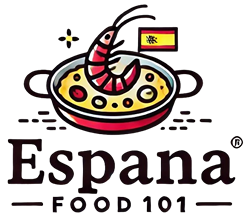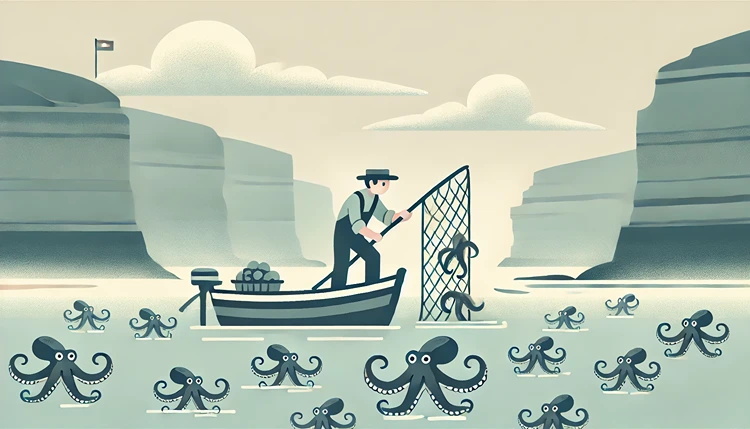Galicia, located in the northwest corner of Spain, is famous for its misty landscapes, rugged coastlines, and unpredictable weather patterns. But one thing that has remained constant over the centuries is the region’s passion for its cuisine, particularly the beloved pulpo (octopus). This signature dish of Galicia, often served as pulpo a la gallega (Galician-style octopus), reflects not just the region’s culinary traditions but also how its coastal climate influences the preparation and flavor of its food.
Today, we’re exploring how the unique climate of Galicia plays a role in shaping its octopus recipes. The coastal winds, humidity, and temperate weather not only influence the ingredients available but also how food is prepared and preserved, resulting in distinctive flavors that define Galician cooking.
Why is Galicia’s Climate So Important to Its Cuisine?
Galicia’s climate is unique in Spain, characterized by a combination of maritime winds, high humidity, and mild temperatures. Unlike the dry, hot conditions found in other parts of Spain, Galicia experiences cool, damp air brought in from the Atlantic Ocean. These factors create an environment where the ocean plays a central role in life—not just economically, but culturally and gastronomically.
Helpful Hint:
Galicia’s weather often dictates its cooking methods. Long, cool days lend themselves to slow-cooking techniques like stewing, which enhances the natural flavors of seafood, such as octopus. The climate also preserves the natural moisture in foods, contributing to their tenderness and richness.
How the Atlantic Ocean Influences Galician Octopus
Given Galicia’s proximity to the Atlantic, the ocean has an undeniable influence on the local food culture. Octopus fishing has been part of Galician tradition for generations. The cold, nutrient-rich waters provide the perfect breeding ground for high-quality octopuses, which are prized for their flavor and texture. But beyond the ocean’s bounty, the method of preserving and cooking octopus—whether boiling, grilling, or drying—has developed largely in response to the region’s weather patterns.
How Does Humidity Affect Octopus Preparation?
Humidity plays a significant role in how Galicians prepare and store octopus. High humidity levels make it easier to preserve seafood through drying techniques, a common practice in the past when refrigeration wasn’t available. While fresh octopus is widely consumed today, dried octopus (known as polbo seco) still holds a special place in Galicia’s culinary traditions. The drying process not only extends the shelf life but also enhances the octopus’s flavor, concentrating its natural oceanic taste.
How Climate Influences Galician Octopus Recipes
| Climate Factor | Impact on Octopus | Culinary Result |
|---|---|---|
| Cold Atlantic Waters | Enhances the quality of the octopus, making it tender and flavorful. | Soft, delicate texture ideal for pulpo a la gallega. |
| Humidity | Helps retain moisture during cooking, preventing the octopus from becoming tough. | Maintains tenderness and richness in traditional dishes. |
| Slow-Cooking Techniques | Well-suited to the cool climate, allowing flavors to develop over time. | Deeply flavored dishes that highlight the natural taste of the octopus. |
| Winter Fishing Season | Octopus are larger and more flavorful in colder months. | Fuller, richer taste that’s celebrated in seasonal dishes. |
Why Do Galician Recipes Focus on Simplicity?
In Galicia, food is celebrated for its simplicity. The region’s climate supports a slow, methodical approach to cooking that lets natural flavors shine. While the octopus itself is tender and flavorful due to the Atlantic’s cold waters, the typical preparation for pulpo a la gallega is straightforward: boiled octopus is sliced and served on wooden plates with a sprinkling of coarse salt, smoked paprika, and a drizzle of olive oil.
But this simplicity is no accident. Galicia’s climate, with its cool, wet air, helps maintain the octopus’s tenderness. Unlike the hotter, drier parts of Spain where intense flavors dominate, the mild climate allows the natural essence of seafood to be the star of the show.
Does the Weather Affect Cooking Techniques?
Absolutely. The cool weather in Galicia is ideal for slow-cooking techniques like boiling and stewing. These methods, combined with the region’s access to fresh, high-quality seafood, result in dishes that are moist, tender, and flavorful without the need for complex seasonings.
Stats:
Galicia experiences over 150 rainy days a year, with an average temperature of 12-15°C (53-59°F). These temperate conditions help maintain moisture levels in seafood, particularly in octopus, which retains its tenderness and rich flavor even after cooking.
Seasonality of Octopus Fishing in Galicia
In Galicia, the octopus fishing season plays a significant role in shaping local recipes. Typically, octopus is fished during the cooler months from October to May. The colder waters during this time not only make the octopus easier to catch but also improve its quality. Local fishermen take pride in sustainable practices, ensuring that only mature octopuses are harvested, preserving the species for future generations.
The seasonality of octopus directly impacts the availability of the dish in restaurants and homes. In fact, during the off-season, many families rely on preserved or dried octopus, which brings a different texture and flavor to the table.
Why Is Winter the Best Time for Octopus in Galicia?
Winter in Galicia, with its cold winds and stormy seas, is prime time for octopus fishing. Octopuses are often plumper and more flavorful in the winter months because they’ve spent the warmer seasons feeding and growing. The cool water temperature is also less stressful for the octopus, which contributes to its tender texture when cooked.
During this time, many restaurants offer seasonal dishes that highlight the freshest catches, and families prepare octopus for special occasions like Christmas and local festivals.
What Makes Pulpo a la Gallega Special?
One of the most famous octopus dishes in Spain is undoubtedly pulpo a la gallega. But what sets it apart from other octopus dishes? Much of it has to do with the simple, yet effective, preparation method and how the region’s weather conditions ensure the octopus remains tender and full of flavor.
Pulpo a la gallega relies on just a few ingredients: octopus, salt, paprika, and olive oil. However, the secret lies in how it’s cooked. The octopus is boiled in copper cauldrons—a traditional method in Galicia—and then sliced thinly before being served. The result is a dish where the octopus is the star, with the smoky paprika and high-quality olive oil enhancing its natural flavor.
In this dish, the focus is on texture. The octopus is soft, yet slightly chewy, and the natural saltiness from the ocean is perfectly balanced by the spices.
Galician Festivals Celebrating Octopus
Galicia is home to numerous festivals celebrating its rich culinary heritage, and octopus takes center stage in many of these celebrations. One of the most famous events is the Festa do Pulpo (Octopus Festival) in Carballiño, held every August. Thousands of people flock to this small town to indulge in large portions of pulpo a la gallega, enjoying it alongside other regional specialties. These festivals are a testament to how deeply intertwined octopus is with Galician identity.
But why celebrate octopus? It’s more than just a dish in Galicia—it’s a symbol of the region’s maritime culture and a reflection of how the local climate shapes the daily lives of the Galician people. The festivals provide an opportunity for locals and visitors alike to honor both the sea and the land, enjoying the unique flavors that are only possible in Galicia.
How Do Festivals Reinforce Traditional Cooking Methods?
At these festivals, cooking methods remain traditional. Large copper cauldrons are used to boil the octopus in the open air, just as it has been done for centuries. The humid, coastal air helps maintain the perfect moisture level, preventing the octopus from becoming dry or tough. Visitors get to experience firsthand how the region’s climate and traditions come together to create a dish that’s simple but profound in flavor.
Helpful Hint:
If you ever attend a Galician food festival, look for octopus cooked in copper pots. The copper helps evenly distribute heat, ensuring that the octopus is cooked to perfection. This method has been passed down through generations and is one of the secrets behind the tender, flavorful pulpo a la gallega.
Influences from Neighboring Regions on Galician Octopus Recipes
While Galicia’s octopus dishes are rooted in local traditions, the region has also absorbed influences from neighboring areas like Asturias and Portugal. Both regions share a love of seafood, and their climates are similarly coastal and temperate, which means they face similar challenges and opportunities in preparing octopus.
What Role Does Portuguese Cuisine Play?
Portugal, just to the south of Galicia, is another octopus-loving region, with its own versions of octopus dishes, such as polvo à lagareiro, where the octopus is roasted with potatoes and olive oil. The cross-border influence between these regions can be seen in the variety of ways Galicians now cook octopus. Roasting, grilling, and even marinating octopus have become more common, adding diversity to a tradition that was once dominated by boiling.
That said, the Galician climate still dictates the dominant cooking methods. Boiling remains popular because it allows the octopus to stay moist in the region’s cooler weather, which is less suited to methods like grilling that tend to dry out the meat.
How Does Asturias Influence Galician Seafood Dishes?
Asturias, Galicia’s neighbor to the east, also shares a climate defined by its proximity to the ocean. Asturias has long been known for its stews, and this influence can be seen in the way some Galicians prepare octopus. For example, octopus stews made with potatoes, garlic, and onions are becoming more popular, particularly in inland areas where the cooler climate encourages heartier meals. This blend of Galician and Asturian culinary techniques showcases the way climate and geography shape regional recipes.
How Has Modern Climate Change Affected Galician Octopus?
In recent years, climate change has begun to affect the seas around Galicia, leading to concerns about the future of the region’s octopus population. Warming ocean temperatures are causing shifts in marine life, with some species moving to cooler waters further north. While octopus remains plentiful in Galicia for now, there are fears that rising temperatures could impact their breeding patterns and overall population.
What Impact Could Warmer Waters Have on Galician Octopus?
Warmer waters affect not only the availability of octopus but also its quality. Octopuses thrive in cold waters, which is why Galician octopuses are so prized for their tenderness. If water temperatures continue to rise, the octopus could become tougher and less flavorful, impacting the beloved pulpo a la gallega.
Additionally, climate change could disrupt fishing seasons. If octopuses begin to migrate to cooler waters earlier in the year, it might shorten the traditional fishing season, limiting the availability of fresh octopus for local recipes.
Stats:
According to recent studies, the average sea surface temperature around Galicia has increased by 0.3°C over the past decade. While this may not seem like much, even slight changes can have significant impacts on marine ecosystems, including the habitat of octopuses.
Preserving Tradition: Sustainable Fishing Practices in Galicia
Despite the challenges posed by climate change, Galicia remains committed to sustainable fishing practices. Local fishermen adhere to strict regulations that limit the number of octopuses that can be caught each season. These measures ensure that the octopus population remains healthy, preserving this culinary tradition for future generations.
What Role Do Fishing Quotas Play in Protecting Octopus?
Fishing quotas are an essential part of Galicia’s approach to sustainability. By limiting the number of octopuses that can be caught each season, fishermen help prevent overfishing and ensure that the octopus population remains stable. This careful management of marine resources is critical in a region where octopus is such an important part of the local culture and economy.
Helpful Hint:
When buying octopus in Galicia, look for labels indicating that it was sustainably caught. This ensures that you’re supporting practices that help preserve the region’s marine life for future generations.
FAQs
Wrapping Up
Galicia’s climate has a profound impact on how octopus is caught, prepared, and enjoyed. From the cold Atlantic waters that produce tender, flavorful octopuses to the slow-cooking methods shaped by the region’s cool, humid air, climate plays a key role in defining the signature dish, pulpo a la gallega. The sustainability practices in place ensure that these culinary traditions can be passed down through generations, even as climate change presents new challenges.
Whether you’re savoring a plate of pulpo at a local festival or enjoying it at a quiet seaside tavern, the unique conditions of Galicia’s coastal environment have a lasting influence on each bite. The octopus, in its many preparations, is a reflection of the region’s natural bounty and the time-honored traditions that shape the Galician way of life. By understanding the link between climate and cuisine, you gain a deeper appreciation for why Galicia remains a culinary gem in Spain.







